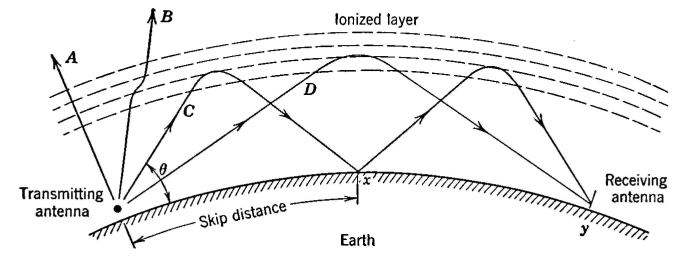| Electrical Communication is a free textbook on the basics of communication technology. See the editorial for more information.... |

|

Home  Radio Wave Propagation and Antennas Radio Wave Propagation and Antennas  Maximum Usable Frequencies Maximum Usable Frequencies |
|||||






|
|||||
Maximum Usable FrequenciesIf a wave is directed vertically upward and if the frequency is sufficiently high, then no ionospheric reflection will occur. As previously explained, the penetration, or critical, frequency is the highest frequency reflected at vertical incidence, illustrated by ray A of Fig. 7. If the transmitting antenna is also sending (at this same frequency) ray B at the angle indicated, some bending of the ray will occur, but not enough to cause reflection. If, however, a ray is sent at a critical angle θ, as with ray C, then the bending will be sufficient to cause reflection back to the earth. The skip distance1 shown is "the minimum distance at which radio waves of a specified frequency can be transmitted at a specified time between two points on the earth by reflection from the regular ionized layers of the ionosphere. Reflected waves are received at less distance only by sporadic, scattered, or zigzag reflections." These are erratic and unsatisfactory for reliable communication.
When a ray such as C of Fig. 7 strikes the earth, absorption of energy occurs; also, the wave is reflected, and the signal may reach point y. A wave is said1 to reach point x by a single-hop path, and to reach point y by a double-hop path. Ray D sent out by the antenna reaches point y by a single-hop path. The signal voltage induced in the receiving antenna will be due to the combined effects of the two (or more) rays. The effect of the angle of radiation on radio signals of the same frequency was considered in the preceding paragraphs. The effect of frequency on radio signals radiated at the same angle will now be considered, using Fig. 8. At some frequency f1 the ray will not be reflected but will pass even through the F layer. At a lower frequency f2 the ray will pass through the E layer, but reflection back to the earth will occur from the F layer. At a lower frequency f3 the ray will be reflected by the E layer. From phenomena just considered, it follows that there is a maximum usable frequency, defined1 as "the highest frequency that can be used for radio transmission at a specified time between two points on the earth by reflection from the regular ionized layers of the ionosphere. Higher frequencies are transmitted only by sporadic and scattered reflections." For instance, suppose that the transmitting antenna of Fig. 7 is to provide a signal at point x. For a given ionosphere height (existing at that specific time), the signal can be provided by ray C which leaves the antenna at a critical angle for some
frequency. A higher frequency at this angle will not be reflected, and, if sent at a lower angle so that it will be reflected, it will miss point x. The maximum usable frequency fm is (neglecting the earth's curvature) approximately8
where d is the horizontal distance from the transmitting to the receiving antenna, h is the virtual height of the reflecting layer under consideration, and fc is the penetration or critical frequency. The units d and h should be the same.
|
|||||
Home  Radio Wave Propagation and Antennas Radio Wave Propagation and Antennas  Maximum Usable Frequencies Maximum Usable Frequencies |
|||||
Last Update: 2011-05-30




